New Education Policy 2020 (NEP 2020)- A Complete Overview
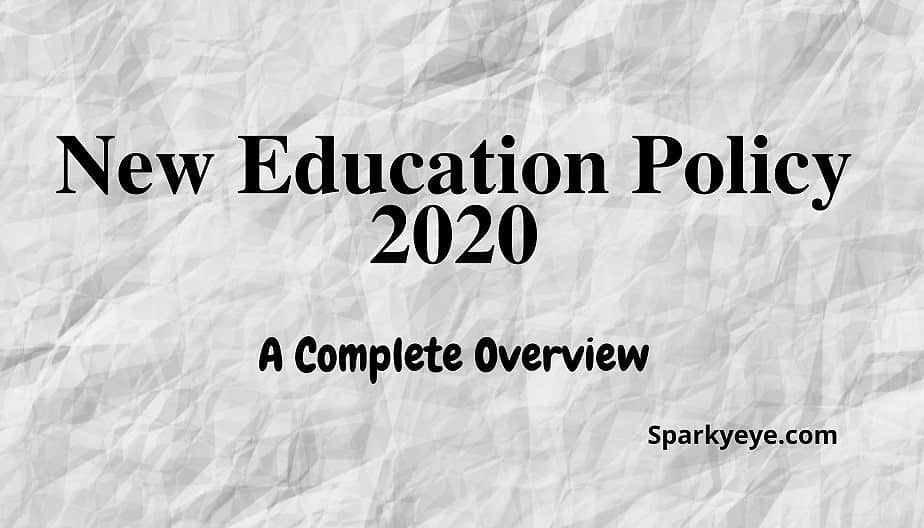
Education in our common sense is a way of learning, through which skills, knowledge, experiences, and also habits of a genus of People are going to transfer from one generation to another generation through teaching, training, and research.
It is necessary to provide universal access to quality education in a country like India which is the 2nd largest populated country and soon by 2027, it will become the country with the highest population according to the UN 2019 World Population Prospects report.
India will become the country with the highest young population by the next decade. So it is pretty much important to educate the upcoming generation with new techniques and provide high-quality educational opportunities.

Every country has its educational policy to serve its people and society which affects the country’s development and many more things. Recently India implemented a New Education Policy in 2020 after a long period of 34 years.
Here I will discuss the New Education Policy (NEP 2020), the importance of education policy, the history of education policies to date, various key aspects of NEP 2020, the implementation timeline, difficulties in the road of NEP 2020, etc.
Let’s go through some interesting points and facts before getting deep into them.
Development of Indian Education Post-Independence
India got independence in 1947. Soon after this Government realized that educational availability for each of its citizens was its top priority.
Caste and gender discrimination were one of the main obstacles to the healthy development of Indian society back then. To get rid of this problem, the Government made them Illicit by the Indian constitution.
To make it effective the government made an amendment called “The 86th Constitutional amendment” which establishes Elementary education as a fundamental right for children between the ages of 6 to 14.
The Indian government takes a lot of steps in establishing and improving the educational infrastructure to date to make people erudite.
The following points will make you understand better the development of Indian education post-independence:-
1. Expansion of General Education Among Common People.
2. Establishments of Technical Institutes throughout the country.
3. Improving the Education system and spreading education among Women.
4. Vocationalization of Secondary Education.
5. Improving Higher Education opportunities for students.
6. Improving Science Education and spreading its necessity among students.
7. Gave importance to Adult Education.
8. Development of Non-Formal Education among 6-14 years of children.
9. Considering Regional languages as a medium for education throughout the country.
At Present (Before NEP 2020 comes into effect) the Indian education system comprises of main 4 steps-
A. Primary Education.
B. Secondary Education.
C. Senior Secondary Education.
D. Higher Education.
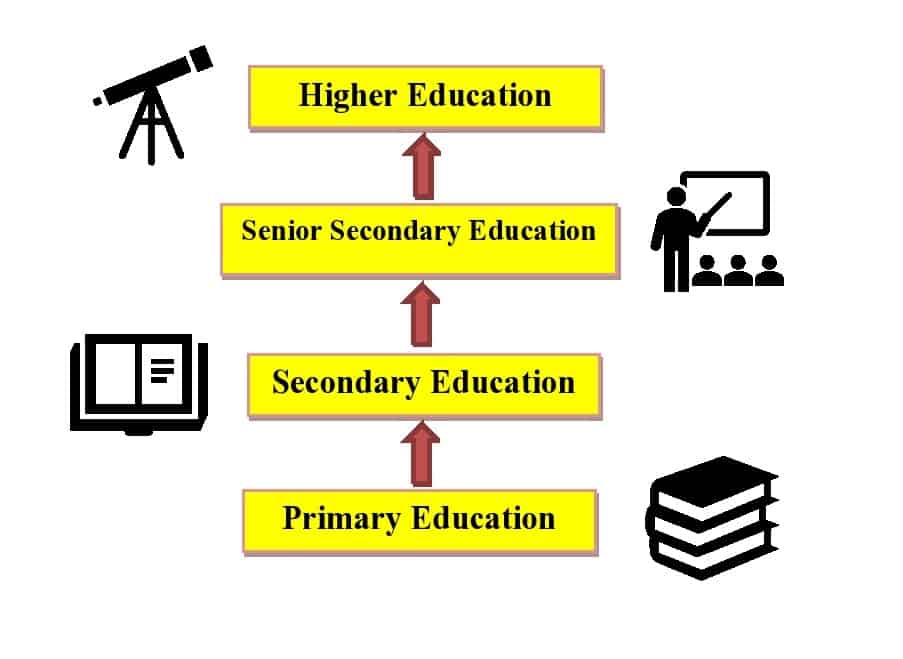
Primary Education Comprises 8 years of education generally. (Class I to VIII)
Secondary Education consists of 2 years of education (Class IX to X) as well as Senior Secondary Education also consists of 2 years (Class XI to XII).
Whereas Higher Education begins only after passing the 12th standard exam. Graduation completion can take up to 3 to 5 years relying on the course one chooses.
Post Graduation courses are of 2 to 3 years of duration generally. After Post graduation, there is also the scope of doing research depending upon one’s interest.
Now we have already seen the development of the Indian education system post-independence.
Let’s go ahead with Education Policy.
What is Education Policy and its Importance
In simple words, Education policy is the combination of principles and various government policies within the educational orbit and the collection of laws and rules that are required for operating the whole education system.
In India, Education has many phases and layers within it. A person can become educated through different institutions by going through different stages.
For example- In our early childhood we get admitted to kindergarten (also known as nursery schools in many parts of India), then we go on learning from class I to Class XII, 2 to 5 years of college or university study for graduation,2 to 3 years for post graduation (The duration may vary relying on the course one chooses), Researching (depend on one’s interest), etc.
So as you can see, maintaining the quality of education at all these levels is very important. People in India engage with education at all ages. So it is very much important to make the system run smoothly without having any difficulties at any stage.
Here comes the need for an Education Policy and its importance in the perspective of a country’s growth.
Apart from this, A policy is very important as they assist a school, college, or university in establishing rules and regulations helping in creating quality standards for learning and meeting up with expectations.
Except for these, an institution will feel the absence of a proper structure due to which it would not be able to fulfill the educational needs of students. One more important thing is safety for which a policy will help in making proper guidelines.
History of Various Educational Policies
After India’s independence, the first commission appointed was the “University Education Commission” of 1948 under the Presidency of Dr. S. Radhakrishnan, to address the University education status of India and suggest improvements and extensions which would be graceful to suit the requirements of present and future situations.
In 1952, under the Presidency of Dr. A. Lakshmanaswami Murlidhar the “Secondary Education Commission” started its work. It submitted its report to the Government in 1953. The report gives an overview of the educational problems of normal people and proposes to enhance the efficiency of production.
After these reports came into effect, the need for a policy was first felt in 1964. Congress MP Siddheshwar Prasad deeply condemned the efforts of the Government regarding the steps taken by Govt, also for having no vision and principles for spreading education in every corner of the country.
After all these incidents, in 1964 an Education commission had 17 members headed by Mr. D. S. Kothari, Generally known as the “Kothari Commission” was constituted. As per the suggestions of this commission, the Parliament passed the first Education Policy of India in 1968.
The next NEP came into action in 1986. Its main objective was to provide education to each part of society mainly focusing on SC, ST, other Backward classes, and most importantly Women, who were pretty much deprived of educational benefits.
It was revised in 1992 with a focus on enhancing the scope of quality education.
If you look at the history of India, every few decades a new NEP comes naturally. Till 2020 India has 3 NEPs. The 3rd and most recent NEP was released on 29th July 2020 under the Prime Ministership of Narendra Modi.
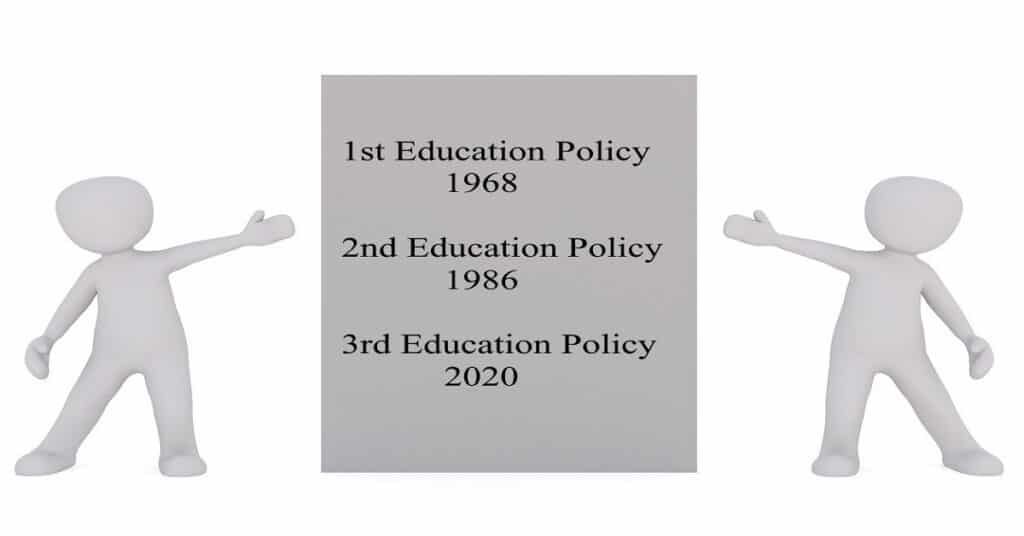
let’s go ahead to see what the New Education policy 2020 is offering to us.
Education Policy 2020
The first Education Policy came in 1968, then the 2nd education policy in 1986, which got revised in 1992. After this, a lengthy period of 28 years is gone when India is running with the old policy.
In these past years, the world is going through rapid changes in the ground of knowledge. Various Scientific and Technological aspects are continuously getting upgraded.
As the world is moving towards digitalization, skill is becoming very much important in every part of education.
Nowadays Only knowledge will not give you a better opportunity but you will also need the skills to implement it effectively. The gap between knowledge & implementation should disappear. Then only you can address yourself as an educated person.
Let’s Go Ahead To See How The New Education Policy 2020 Came Into Effect…
How the National Education Policy came into effect (Timeline of Education Policy 2020)
1. The Committee set up for making the draft of the National Education Policy submitted its report on 31st May 2019.
2. The Draft Education Policy was then uploaded to MHRD’s website as well as to MyGov Portal to seek feedback from shareholders including the public. More than 2 lakhs of suggestions it received.
3. The draft of the new NEP was then submitted by a panel led by former ISRO chief K. Kasturirangan to the Union Human Resource Development Minister.
4. After the submission, States and UT Govt. also Govt. of India were invited to give their views and suggestions on the draft. According to the Govt. of India, They had approached approximately 2.5 lakh gram panchayats to consult on NEP 2020.
5. A concise summary of Draft NEP 2020 was prepared and circulated among the stakeholders. It was translated into 22 languages and uploaded on the MHRD’s website. Meetings with various higher authorities were also held in between.
6. An important meeting of the Central Advisory Board of Education (CABE) took place where the Various States and UT’s Education ministers and representatives, CABE members, Vice-chancellors of Reputed Universities as well as Various senior officials of Govt. attended the meeting.
7. A Parliamentary Standing Committee meeting on Draft NEP 2020 was staged on 7th Nov 2019.
8. After all discussions, debates, suggestions, changes, and improvisations, the Final NEP was approved by the Union Cabinet Led by PM Narendra Modi.
Let’s Quickly Go Through An Infographic About How The New Education Policy 2020 Or You Can Say In Short NEP 2020 Came Into Effect So That You Can Easily Visualize The Steps.
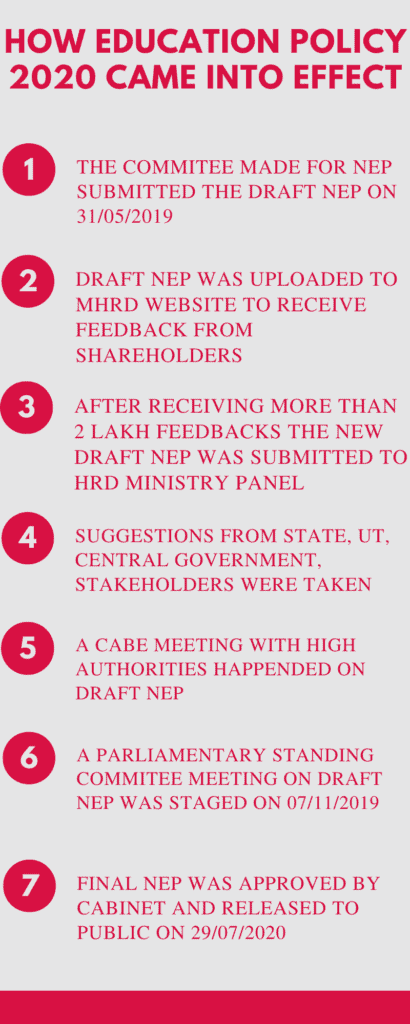
Let’s See What the New Education Policy 2020 Brings for us.
Key changes in School Education
1. Previously the School Education System was based on the 10+2 model. But from now on it will be a 5+3+3+4 Model.
So what is 5+3+3+4… That’s your question right now. Don’t worry, be with us you get to know every detail extensively.
So the New structure of School Education Will be-
A. Foundational Stage (5 Years) – 3 years of Anganwadi/Preschool Stage from 3-6 years of age followed by classes 1 & 2 from 6-8 years of age.
B. Preparatory Stage (3 Years) – Classes 3 to 5 from 8 to 11 years of age.
C. Middle Stage (3 Years) – Classes 6 to 8 from 11 to 14 years of age.
D. Secondary Stage (4 Years) – Classes 9 to 12 from 14 to 18 years of age.
See it’s super easy to understand.
Now Govt. introduces this new system so that children from 3 to 6 years of age can easily access education benefits from an early stage. In the previous system, the institutional education process started at 6 years of age.
Let’s Get Through Two Pictures So That You Can Easily Memorize These Changes. Below Here You Can See The Previous Education System.
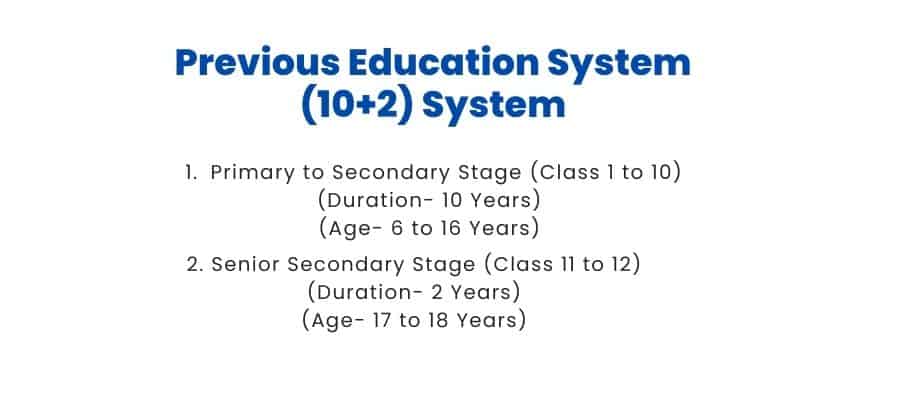
And Below Here Is The Proposed New Education Policy 2020 (NEP 2020).
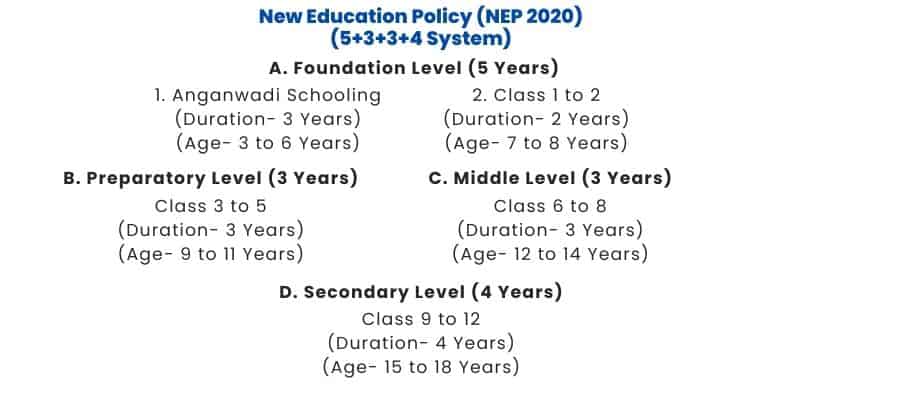
2. Now Up to class 5, schools will be known as Pre-schools, classes 6 to 8 will be Mid Schools, Classes 8 to 11 will be as High Schools & from class 12 onwards will be Graduation.
3. Govt. is going to create a new Basic Learning Program mainly for parents so that they can teach their children at home for up to 3 years and for preschools from 3 to 6 years of age.
4. Now students can take Vocational courses as well as do internships from class 6 & also Coding will be taught to make them experts from early childhood days.
5. Every child should learn about at least one vocational course till the secondary level and is exposed to various others with time.
6. Students have the freedom in choosing subjects from classes 8 to 11. Earlier there were streams named Arts, Commerce, and Science.
7. Medium of study and instructions should be a mother tongue or regional language up to class 5 and may be extended up to class 8.
8. A 3 language formula will be implemented to promote multilingualism among students so that they can explore their studies as per their preferences. Of the 3 languages, 2 must be of Indian Origin.
9. Focus on improvement and implementation of the Sanskrit language in schools as well as in higher education. In the three-language system (as given above) one language option will be Sanskrit.
10. Inclusion of report cards which will include self-assessments of students as well as teachers.
11. Every student has to give school exams in Grades 3, 5 & 8 conducted by the appropriate authority for testing the learning outcomes of students.
12. Each student will be allowed to sit for Board Exams on max. 2 occasions during any school year. One will be the Main Examination and the other one for improvement of marks if needed.
13. Boards exams will be of two parts- Objective type with MCQ and Descriptive.
14. Course curriculum in each subject will be reduced and more focus will be given to Experiential Learning and core knowledge of respective subjects.
15. A 3-month play-based course “School Preparation Module” will be introduced for all Grade 1 students for ensuring they are ready for schooling. NCERT and SCERT will develop the course curriculum.
16. NCERT will develop a curriculum for Early childhood care and education for children up to 8 years which will serve as a guide for both parents and different educational institutions.
17. For smooth integration of early childhood care and education into school education continuous guidance will be required, A special Joint Task Force will be formed for this.
18. Achieving Universal Foundational literacy and Numeracy at the primary school level by 2025 will be the top priority of the Education system.
19. Special care will be taken to Anganwadis, Anganwadis located with Primary schools, etc. They will be strengthened with infrastructures as well as specially trained teachers and workers.
20. There will be an introduction of Ashram Shalas mainly in Tribal dominated parts and in all types of alternative schooling in a phased manner.
21. The Student-Teacher ratio will be kept under 30:1 at each school level and in places where a large number of students are of backward classes, the ratio will be kept under 25:1.
22. A New Teacher Training Board is going to be built up for providing training to all kinds of Teachers around the Country.
23. A guide set of National Professional Standards for Teachers (NPST) will be developed by 2022 by the National Council of Teacher Education under the General Education Council (GEC) with the advice of NCERT & SCERT. They will be prepared for a new assessment system by 2023.
24. A new policy “ National Book Promotion Policy” will be formulated and proper steps will be taken to ensure the availability and accessibility of various books across genres, languages, and geography.
25. A New National Assessment Centre is proposed to set up, PARAKH (Performance Assessment, Review and Analysis of Knowledge for Holistic Development) as a setting body under MHRD which will guide the State Achievement Survey (SAS) and National Achievement Survey (NAS) in monitoring the achievements of learning outcomes in India.
26. A special merit-based scholarship will be introduced in rural parts which will provide local job opportunities to local students, especially females.
To Help You In Visualizing The Important Changes In School Education New Education Policy 2020 Brings, Here Is An Infographic.
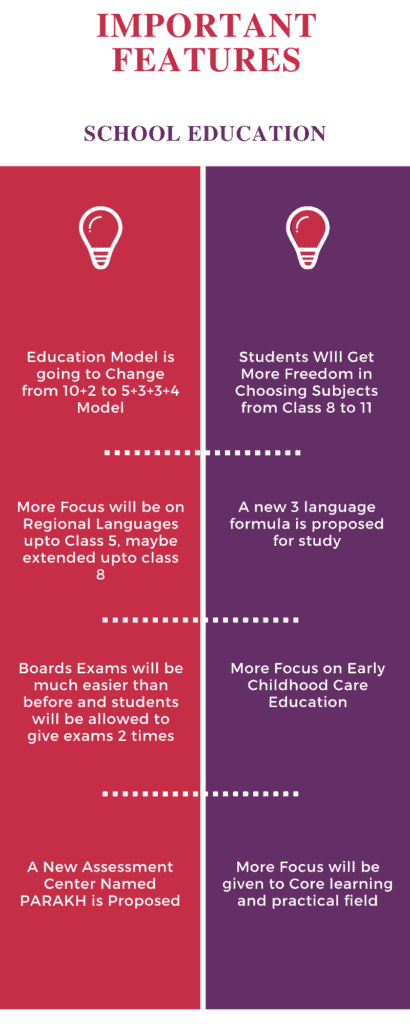
Key changes in Higher Education
1. The National Testing Agency (NTA) will now offer a common Exam to enter College, though it will not be mandatory.
2. All higher education institutions, colleges, and universities will become multidisciplinary by 2030 and gradually increase student strength. There shall be at least one Multidisciplinary Higher Education Institute in or near every district by the same year.
3. Various Engineering Colleges like IIT will become multidisciplinary Institutes that will also offer Arts, Humanities, etc.
4. Multidisciplinary Education and Research Universities (MERU) will be set up as models of Multidisciplinary education systems up to the standard of IITs & IIMs which will represent India at the Global Level.
5. For Those students who have completed 3 years of the Bachelor’s program, the postgraduate program will be of 2 years, in which the 2nd year will be mainly focused entirely on research works.
6. Those students who have completed 4 years of the Bachelor’s degree program with 1 year of research (mainly the last year i.e 4th year which will be devoted to research), for them the Master’s program could be of 1 year duration.
7. A 5 year integrated Bachelor’s/Master’s program may get started.
8. M.Phil Courses will be discontinued. It was mainly a research degree between a Master’s and Ph.D. it will be discontinued so that students move their interest toward Ph.D. Programs.
9. For Undertaking a Ph.D. program, a student must have either a 4 year Bachelor’s degree with research or a Master’s degree.
10. A 4 year integrated B.ED course will be introduced.
11. By 2030, A 4 year integrated B.ED Degree will be considered the minimum degree of qualification for a teacher.
12. There will be multiple entries and exit options with certificates for an undergraduate degree of 3 or 4 years.
For example, if you are doing a 3 or 4-year degree course then,
A. If you leave after 1 year you will get a Basic certificate.
B. If you leave after 2 years you will get a Diploma certificate.
C. And if you leave only after finishing the course you will get a Bachelor’s degree certificate.
If anyone chooses a 4 year degree course, the first 3 years will be considered for the study, whereas the last year will be considered for research purposes (as per one’s preferences). One can easily do research in his/her last year of study which will help him/her in getting out with a certificate on a research degree.
13. All Higher Education Courses and institutes (Excluding Medical and Legal) will be managed by a Single Authority.
14. An introduction to the Credit System in Graduation years for a student. Each year a student will get some credits which he/she can use if he/she takes a break during the course and returns to finish his/her course.
15. For smooth transfer of credits an “Academic Bank of Credits” will be established.
16. By 2035 The Gross Enrolment Ratio (GER) in higher education will be raised to 50%, whereas the current Gross Enrolment ratio (GER) is 26.3.
Additionally, 3.5 Cr. more seats will be added to Higher Education.
17. Various kinds of universities present in India like “Affiliating University”, “Deemed to be University”, “Unitary University”, “Affiliating Technical University” etc will be replaced simply by “University” after fulfilling the criteria.
18. All Affiliated Colleges will be converted into an “Autonomous Degree-Granting College” over 15 years through a graded autonomy system.
19. All kinds of universities (e.g- Government, Private, Open, Deemed, Vocational) present in India will have a common grading system and other rules as well.
20. All Higher Education Institutes will ensure proper support, medical facilities, and hostel facilities for all students especially students from rural backgrounds.
As Earlier Said, To Help You In Visualizing The Important Changes In Higher Education Due To the New Education Policy of 2020, Here Is An Infographic.
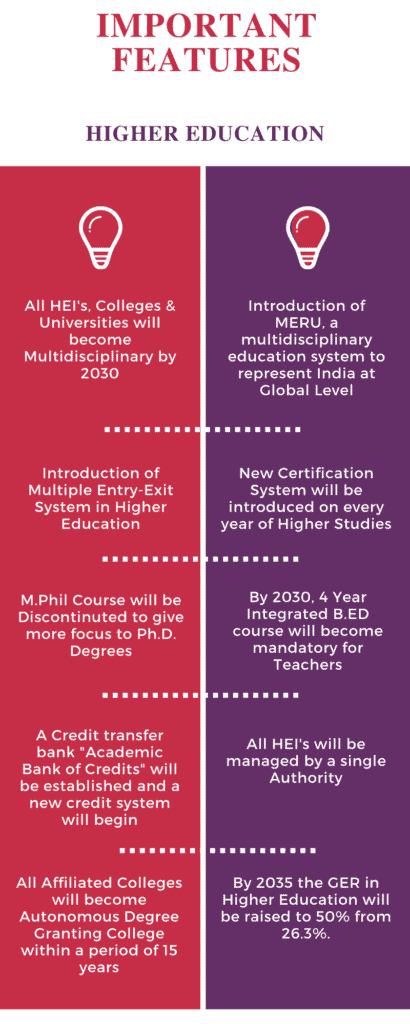
We Have Already Seen A Lot Of Changes That Came Due To the New Education Policy of 2020. Here are some other important changes that the New education policy 2020 brings to us.
Other Various key aspects and changes
1. AICTE and UGC will be merged.
2. The Ministry of Human Resource Development (MHRD) is going to be named the Ministry of Education (MoE).
3. To inspire the backward classes the National Grant Entry is to be extended for SC, ST, OBC, and other SEDG, etc. Free scholarships will also be there.
4. NEP 2020 encourages the setup of foreign universities in India.
5. To grow interested in qualitative research an institute named National Research Foundation (NRF) will be established to develop a culture of research among all college students across the country. It will also give funding for research in all categories.
6. Agriculture institutes must offer benefits to the local community, it could be done by setting up Agricultural Technological Parks.
7. Law colleges must offer bilingual study systems in every state, one language will be English and the other will be as per state language.
8. More focus on Adult Education among students.
9. More focus will be given to the technological aspect. A forum named National Educational Technology Forum (NETF) will be created to exchange ideas related to technology.
10. A variety of educational software will be made to provide knowledge more broadly and will be uploaded on DIKSHA/SWAYAM portal.
Till now we have seen what the new education policy of 2020 offers to us in different stages of the educational journey of a single human being.
As the govt. is aiming to implement all these changes over some time, Let’s take a quick look at the implementation timings of The New Education Policy 2020.
Implementation Timeline
Govt. is looking to transform the whole education system by 2040.
Some Proposals made will be implemented right away, beginning with the change in name of the Ministry of Human Resource Development into the Ministry of Education.
As per higher Education Secretary Mr. Amit Khare, more than 100 points will be implemented phase by phase based on time, region, and types of institutions with central universities and institutes of eminence taking the lead.
For Example, 4 years of UG courses with multiple entries and exit options will be introduced from the academic year 2020-21.
Introduction of a common entrance test by the National Testing Agency (NTA) by December 2020 for allowing admission to all Central Universities and Institutes of Eminence in 2021.
With a target of implementation within 2025, The National Foundation Literacy and Numeracy Mission will be introduced by the end of 2020.
Some IITs are working on developing some technical structure for the Academic Credit Bank going to be established by December 2020.
It may look so simple to implement all these changes which the new education policy 2020 brings to us.
But the road is not as simple as it appears. There will be a lot of difficulties in implementing the proposals of the new Education policy in 2020.
Let’s get a brief idea about what difficulties the new education policy 2020 might face in the upcoming days.
Difficulties on the road to implementation
A. The proposal for the Board of Governors for universities might require amendments to Central and State University acts. To make it a fully autonomous body, an act may be needed.
B. Some proposals may require legal changes.
C. If only a budget allocation is made in the upcoming academic calendar then only the proposal of Free Breakfasts can be considered.
D. Converting the affiliated colleges to degree-granting autonomous institutions and then a complete running university may take up more than 15 years, as Govt. has to provide full financial assistance and various other supports to do so.
E. Though Govt. feels an increase in funding in the educational sector up to 6% of GDP will be more than enough to meet the needs for implementing NEP 2020, as per Experts, the increase in funding for Educational purposes for a long period remains unachieved.
As we are moving very fast towards a digital world, it is very much important that every corner of the country should get access to it. But in reality in huge parts of India, the benefits of digitization didn’t reach to date because of poor internet connectivity or not getting access to technology.
As the NEP 2020 is focusing more on Online Education, it will become pretty tough to reach every corner of India with all these limitations still on.
Conclusion
The NEP 2020 deserves praise as it finds out the faults in our education system and also the failures of previous systems and takes huge steps to redress the problems.
Giving stress on local and regional languages, the use of online platforms, focusing on Effective and practical based learning, freedom of choices for students, focusing on the growth of children in early childhood days, etc. the NEP 2020 has proven its importance for the upcoming future.
It is going to be a dynamic step for education in a more scientific way. It will not only help the children in developing their skills but also it will help him in developing their awareness of the social and physical world as well as the digital world.
If the implementation of this vision becomes successful, then soon India will become as successful as other leading countries of the world.
I hope you will find this article helpful. I have tried my best to give you a complete overview of NEP 2020.
For more details Click Here- NEP 2020.
If you think I missed something important as per your knowledge, do share it with us here through comments, and if you found it valuable then help others by sharing it with them.
For More Valuable Resources Find me on 👉🏽👉🏽 Facebook, Instagram & Twitter.
You Can Also Join Our Facebook Page 👉🏽👉🏽 Sparkyeye- Knowledge is Future.
Also Read-
10 Awesome Ideas to Celebrate The Teachers Day 2023 Virtually.


that was so helpful for my assignment,thanks:)
It’s my pleasure it helped you. 🙂 🙂